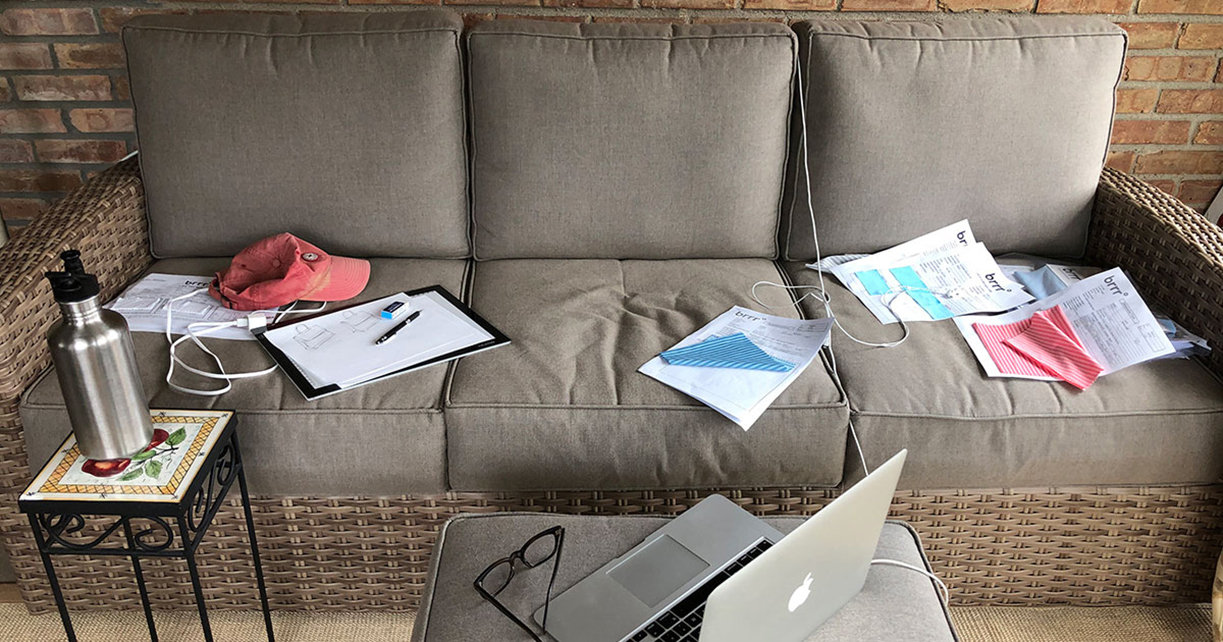Visual essay by Tim Hossler, chair of design, captures makeshift home offices in the first days of COVID

LAWRENCE – Do you remember where you were when the world stopped due to COVID-19 three years ago?
Now, thanks to a visual essay in the journal Visual Studies by Tim Hossler, University of Kansas associate professor of visual communication design, you can flash back to those bad old early days of lockdown at home.
As Americans were being told to shelter in place to avoid a dread new airborne virus for which there was no cure or treatment, Hossler found himself wanting to reach out to friends and neighbors in some way. Inspired by the long-running British Mass-Observation Project, Hossler sent out a request to acquaintances around the globe, saying in part: “I’m asking friends to take a couple photos of where they work at home and email me the images. … I’m wanting to focus on the place and the things we surround ourselves with during this time.”
He received hundreds of responses, from which he took dozens to compose the visual essay titled “Home office: the places where we worked — a directive sent out to friends, friends-of-friends, and colleagues — March/April 2020.”
It’s a series of photos of empty, often jury-rigged work-from-home stations that differ from the perspective of the ubiquitous Zoom call screen with which knowledge workers suddenly became all-too familiar, or the humorous ethos of Room Rater.
Hossler said the project served several functions. Not only did it give him something to do, it served to document a time that would be otherwise difficult to do, given the isolating nature of lockdown. He always had a feeling, he said, that the period would be transitory.
“We didn't know what was going to happen,” Hossler said. “At the beginning of the pandemic, it seemed like, ‘Oh, it's gonna be a couple weeks, and everything will be fine.'”
Of course, it wasn’t fine after a couple of weeks.
If not pure voyeurism, the home office project was at least a chance to change the perspective.
“We were all seeing each other through Zoom at the time,” Hossler said. “You basically saw what was behind the other person. And so I liked the idea of people taking pictures to show more of what the space was like that they were inhabiting at the time.
“And then just seeing all the things that you have around yourself, whether it be the stack of books next to your laptop, or a glass of wine or a Rick James record. … What do we surround ourselves with when we're kind of stuck in this place that we didn't necessarily think we were going to be?”
It was also a chance to document the time — particularly, Hossler said, its rapidly changing technology.
“I think that as time goes on, the photos are going to seem so dated in some ways,” Hossler said. “Technology will be the thing that really stands out — what our laptops look like or what the Zoom interface looks like. Other things like chairs and furniture won't change in the same way the technology does.”
With frame after frame of rooms without any people in them (there is an occasional pet), Hossler said the essay is melancholy, at best, in terms of its emotional effect.
“Yeah, empty rooms,” he said. “I do like it that there is kind of this emptiness to them. You know that the photo is being taken by someone, probably. But that time was weird. I mean, you had the people around … if your family was with you. But also it was a very lonely time.”
Image: Tim Hossler asked friends and colleagues in 2020 to photograph their lockdown work spaces for a new visual essay that recalls the early days of the COVID-19 pandemic. Credit: Courtesy Tim Hossler
The University of Kansas is a major comprehensive research and teaching university. The university's mission is to lift students and society by educating leaders, building healthy communities and making discoveries that change the world. The KU News Service is the central public relations office for the Lawrence campus.